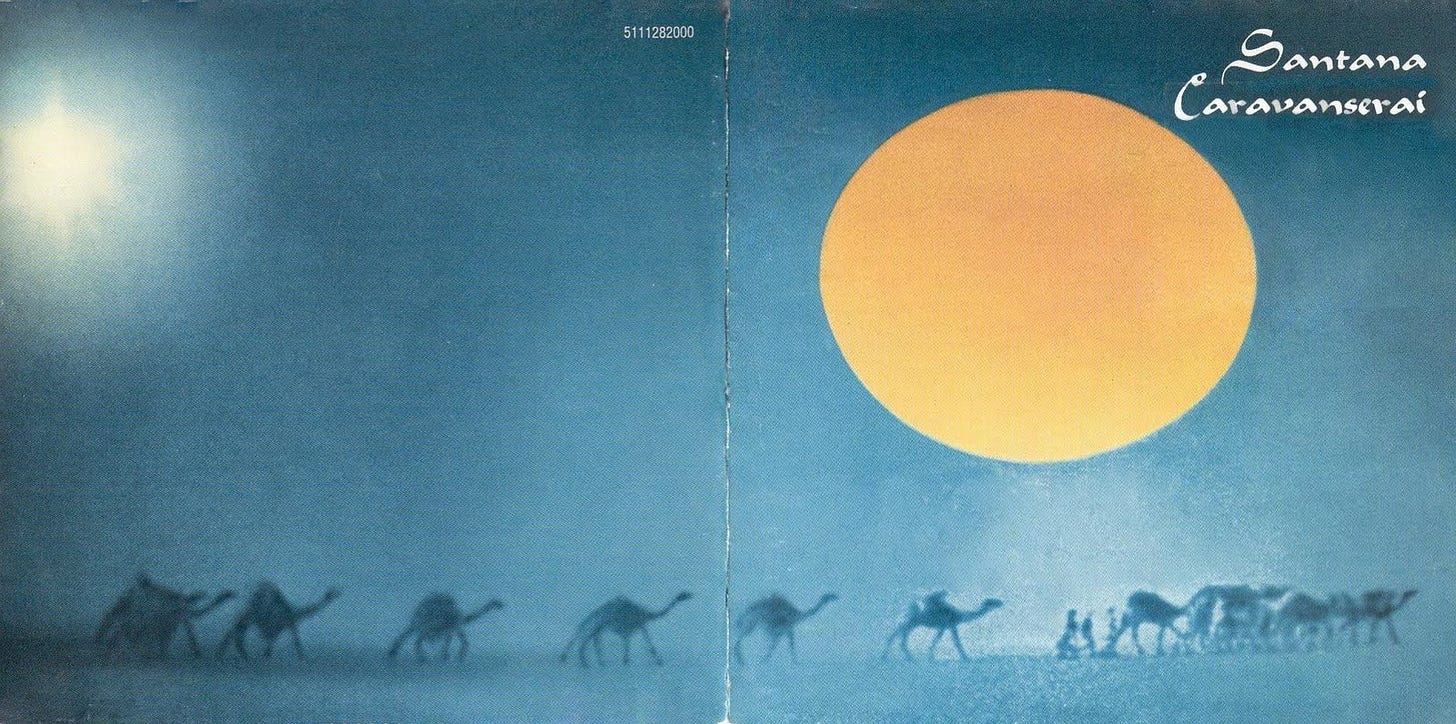Santana Caravanserai - 50 Years On
Another in a series of 50 year anniversary albums, Santana's masterpiece was released on October 11, 1972. Clive Davis, then head of Columbia Records, called it "career suicide."
Crickets… that’s how side one, track one begins… 30 seconds of crickets. No soaring guitar solo from Carlos Santana, just crickets and then the sound of a lonely saxophone. This was clearly a new sound from the band that stole the show at Woodstock and followed up with a brilliant second album that included “Black Magic Woman” and “Oye Como Va.” Their fourth album was not radio-friendly material for 1972.
But by the end of side one, we begin to see a picture of the universe from all its many perspectives. The percussion we have come to know from Santana is all there. Beginning with the second track, we hear Carlos do his runs on lead guitar that he attributed to his father’s insistence on learning the violin at age 5. He told Guitar World magazine that “hearing the electric guitar for the first time was “an assault on the senses” and “gateway to eternity.”
Produced by Carlos and the drummer that mesmerized us all in the Woodstock movie, Michael Shrieve, the album appears to seamlessly move from song to song as one thought. Many band members contributed to the song writing and, in a collective fashion, credits go to multiple members for each song.
And yet, the band was falling apart.
Two of the original members of the group, percussionist Michael Carabello and bassist David Brown, had already left the band when they entered the studio. After this album, guitarist Neil Schon (18 years old at the time) and keyboardist, Gregg Rolie would form Journey.
Caravanserai would be the band’s undoing, but what a beautiful legacy they left us.
My personal favorite in their entire catalog, the album becomes richer with every listen. The soaring end to side one begins with “Just in Time to See the Sun” – a song that can lift anyone out of the dark and into a beautiful place. Then what could be Carlos’s most expressive solo in “Song of the Wind,” written by Santana, Rolie and Schon, lifts us even further into this universe that we began to glimpse in those first few minutes of track one: “Eternal Caravan of Reincarnation.” The final cut on side one, “All the Love of the Universe” seals the deal:
New thoughts
Will purify my mind
And clean my body
New lives
Will fall together like an endless story
All the love of the universe
Will be shared by all that’s living
Much later in Rolie’s career, he reflected on how at the time, he thought the direction of the album was a mistake: “The other point is that personally we were all upside down. Carlos puts it well these days when he says, “We didn’t treat each other too good.” That’s exactly it. It was too much too soon. We had the world by the balls and didn’t realize it. That’s what happened. But talk about having a moment in time? I was so proud of what was created with this. So proud.” (Rolling Stone, 21 Nov 2019)
From “The Story behind Caravanserai,” in the excellent music blog The Music Aficionado, we learn about the origin of the album’s name: In the Near East, the word Caravanserai means a large courtyard that provides accommodation for caravans, or simply a group of people travelling together. But Carlos Santana found a different meaning for it when he was reading a text by Indian yogi and guru Paramahansa Yogananda: “The caravan is the eternal cycle of reincarnation, every soul going into and out of life, from death to life and back again, until you arrive at a place where you can rest and achieve an inner peace. That place is the caravanserai.”
The final song on the album might be their most profound and moving instrumental: “Every Step of the Way.” It was Carlos’ favorite on the album. In his biography The Universal Tone, Santana says of this track: “For two reasons my favorite song on Caravanserai is Every Step of the Way – first because it sounds like what we really loved back then: Herbie Hancock’s Crossings. The song also reminds me of Shrieve because he wrote it and because of how we played together.”
The members of Santana created a timeless piece of music on Caravanserai. To this day, every listen feels like your first time. Now, it’s so calming when the needle drops to the sound of crickets and sax… I know I just need to settle in, empty my thoughts, and let the music take me to that other place “where I can rest and achieve inner peace.”




I saw Santana in concert at Notre Dame University after this album came out. They played the album in its entirety plus added improvisations. They played nonstop for over an hour and a half. None of their previous hits and music. Just this album. It was terrific. I can still hear it to this day. The one thing about Carlos is he would do it his way. And what a way it's been.
Pete- Ever since you originally wrote this piece I have listened to the album twice. Tonight I listened for a 3rd time. Thank you for bringing this masterpiece to my attention. As you said, a greater appreciation occurs upon each listen. One of the best things about subscribing to a music service (in my case, Spotify) is that you can explore the compete catalog of your favorite artists- albums that escaped your notice back in the day. After all, there was so much great music being produced then that it was hard to wrap your head around most of. Too many great albums fell through the cracks and now we have the time to rediscover them. Your insights made this all the more rich. Thanks again.